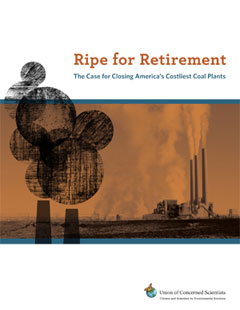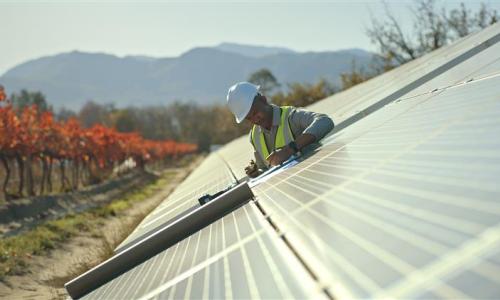As many as 329 coal-fired power generators in 38 states — representing 58.7 gigawatts (GW) of power capacity — are no longer economically competitive compared to a typical existing natural gas plant. They are ripe for retirement and should be considered for closure.
This 2013 update to the report, Ripe for Retirement: The Case for Closing America's Costliest Coal Plants, also includes a comparison with new wind power facilities and determines that as much as 71 GW of coal-fired generating capacity is uncompetitive with this renewable energy source.
These currently operating, ripe-for-retirement generators are in addition to the 138 coal generators (18 GW) that retired between 2011 and 2013, and the 170 coal generators (35 GW) that have already been announced for retirement as of December 2013. Collectively, these three categories account for more than a third of the country's coal-generating capacity.
As this analysis illustrates, the U.S. energy landscape is rapidly changing — and presents a unique opportunity to move the U.S. toward a cleaner energy future.
A growing number of coal-fired generators can't compete with natural gas
- A coal-fired power generating unit, or generator (a power plant comprises one or more generators), is deemed ripe for retirement if it would cost more to operate — including the costs of installing any needed pollution controls — than a typical cleaner-burning and more efficient natural gas plant or new wind facility.
MAP: Ripe-for-Retirement Coal Generators - The original Ripe for Retirement analysis (2012) identified up to 353 (59 GW) generators as ripe for retirement when compared to a typical existing natural gas combined cycle (NGCC) plant. As of December 2013, 73 of these units (10 GW) have either retired or been announced for retirement.
- 69 additional coal units (11 GW) are now deemed as ripe for retirement in this 2013 update, which draws on the most current data available for the U.S. coal fleet and incorporates updated cost and performance information for natural gas.
Ripe-for-retirement capacity varies by region and scenario
-
The relative economic competitiveness of coal-fired generators was determined by comparing them to an average existing and new natural gas plant, with and without a carbon price of $20 per ton of CO2; and to new wind facilities with and without the federal production tax credit (PTC).
CHART: Results of Ripe for Retirement Scenarios -
Most ripe-for-retirement capacity is concentrated in the Southeast and Midwest when compared with existing natural gas plants without a carbon price.
-
In this natural gas scenario, Michigan, Florida, Alabama, Georgia, and Indiana top the list with the most ripe-for-retirement capacity, and 44 percent of the total is owned and operated by just five power companies, including Southern Company, Tennessee Valley Authority, Duke Energy, DTE Energy, and CMS Energy.
-
Comparing coal generators to new wind facilities with tax credits in place moved several states with strong wind energy resources higher up in the rankings. In this scenario, Texas, Michigan, Alabama, Georgia, and Oklahoma top the list.
-
For detailed information about each scenario, please see the tables below.
Every region of the country has the potential to replace the electricity from ripe-for-retirement coal generators with cleaner alternatives
- A combination of projected new renewable energy generation and energy efficiency savings from current state policies, along with underutilized existing natural gas plants, can more than replace the generation of coal units retired between 2011 and 2013, units currently slated for retirement, and all generators deemed ripe for retirement.
- Substantial excess capacity is available if existing natural gas plants are ramped up to their full technical potential.
The choices we make today to replace retiring coal plants will determine our electricity sources for decades to come
- Many utilities are replacing generation from retiring coal plants with natural gas, but a significant increase in the nation's dependence on natural gas has many risks. These include a failure to effectively address climate change, as well as economic risks associated with rising and potentially volatile natural gas prices.
- A diversified electricity system — with amplified roles for renewable energy and energy efficiency and a modest role for natural gas — would both limit the threat of climate change and mitigate the long-term risks of an overdependence on natural gas.
- To move the country towards a cleaner, more diverse energy future depends critically on policies such as a national power plant carbon standard, strong renewable electricity standards and energy efficiency standards, tax credits, investments in research and development, and improved processes for the planning, siting, and financing of needed transmission projects.
Supporting data and resources
Tables (PDFs):
- Coal Generators Identified as Ripe for Retirement (Compared to Existing NGCC)
- Coal Generators Identified as Ripe for Retirement (Compared to Wind with Tax Credit)
- Coal Generators Announced for Retirement or Conversion
- State Ranking of Combined Coal Generators Announced for Retirement plus Coal Generators Identified as Ripe for Retirement Compared to Existing NGCC
- State Ranking of Ripe-for-Retirement Coal Generators (Compared to Wind with Tax Credit)
- State Ranking of Ripe-for-Retirement Coal Generators (Compared to Existing NGCC)
- Top 25 Power Companies with Most Ripe-for-Retirement Generators (Compared to Wind with Tax Credit)
- Top 25 Power Companies with Most Ripe-for-Retirement Generators (Compared to Existing NGCC)
PowerPoint Presentation (PDF)
Downloads
Citation
Lesley Fleischman, Rachel Cleetus, Jeff Deyette, Steve Clemmer, Steve Frenkel. Ripe for Retirement: An Economic Analysis of the U.S. Coal Fleet. The Electricity Journal, Volume 26, Issue 10, December 2013, Pages 51–63.




